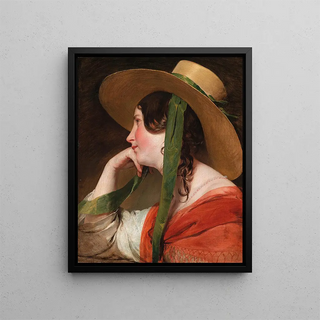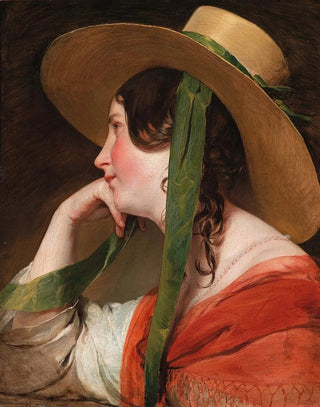Art print | Girl with Straw Hat - Friedrich von Amerling


View from behind

Frame (optional)
The art print "Fille au chapeau de paille" by Friedrich von Amerling is a piece that immediately evokes an atmosphere of lightness and grace. Created in the 19th century, this iconic work perfectly illustrates the talent of the Austrian artist, capable of capturing fleeting moments of beauty and elegance. The depiction of a young woman with a delicate face, adorned with a straw hat, invites the viewer to immerse themselves in a world of refinement and softness. Light plays on the textures of the clothing and facial features, creating a visual harmony that delights anyone in front of this art print. Amerling, through his realistic approach, manages to transcend the simple portrait to offer a true emotional experience.
Style and uniqueness of the work
The style of Amerling is distinguished by its finesse and attention to detail. In "Fille au chapeau de paille," the color palette, both soft and luminous, helps create a serene atmosphere. Pastel shades and bursts of light evoke a sense of freshness, while the meticulous details of the hat and clothing highlight the artist's virtuosity. The composition is carefully balanced, with a natural pose that brings the character to life. Amerling succeeds in capturing not only the physical beauty of his model but also a certain inner depth, an introspection that invites contemplation. This blend of realism and romanticism characterizes his work and gives it a timeless dimension.
The artist and his influence
Friedrich von Amerling, born in 1803 in Vienna, is one of the most renowned painters of the Austrian academic movement. Trained in the ateliers of great masters, he developed a style that combines tradition and innovation. Amerling established himself in the artistic circles of his time, creating numerous portraits of Viennese high society. His influence is felt not only through his own works but also by the impact he had on his contemporaries and subsequent generations. By drawing inspiration from the techniques of old masters while incorporating elements of modernity, he paved the way for a new vision of portrait art.

Matte finish

View from behind

Frame (optional)
The art print "Fille au chapeau de paille" by Friedrich von Amerling is a piece that immediately evokes an atmosphere of lightness and grace. Created in the 19th century, this iconic work perfectly illustrates the talent of the Austrian artist, capable of capturing fleeting moments of beauty and elegance. The depiction of a young woman with a delicate face, adorned with a straw hat, invites the viewer to immerse themselves in a world of refinement and softness. Light plays on the textures of the clothing and facial features, creating a visual harmony that delights anyone in front of this art print. Amerling, through his realistic approach, manages to transcend the simple portrait to offer a true emotional experience.
Style and uniqueness of the work
The style of Amerling is distinguished by its finesse and attention to detail. In "Fille au chapeau de paille," the color palette, both soft and luminous, helps create a serene atmosphere. Pastel shades and bursts of light evoke a sense of freshness, while the meticulous details of the hat and clothing highlight the artist's virtuosity. The composition is carefully balanced, with a natural pose that brings the character to life. Amerling succeeds in capturing not only the physical beauty of his model but also a certain inner depth, an introspection that invites contemplation. This blend of realism and romanticism characterizes his work and gives it a timeless dimension.
The artist and his influence
Friedrich von Amerling, born in 1803 in Vienna, is one of the most renowned painters of the Austrian academic movement. Trained in the ateliers of great masters, he developed a style that combines tradition and innovation. Amerling established himself in the artistic circles of his time, creating numerous portraits of Viennese high society. His influence is felt not only through his own works but also by the impact he had on his contemporaries and subsequent generations. By drawing inspiration from the techniques of old masters while incorporating elements of modernity, he paved the way for a new vision of portrait art.






